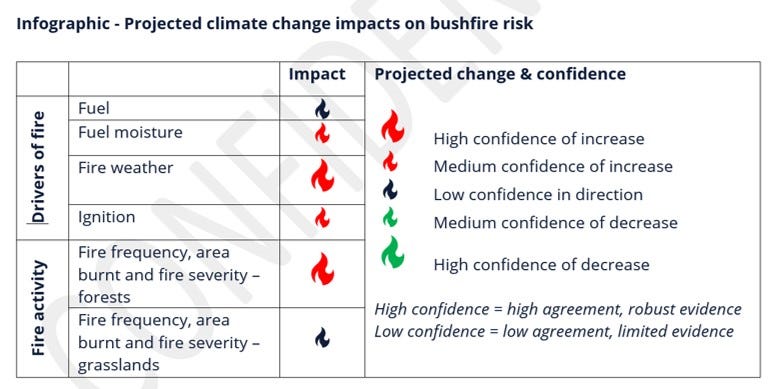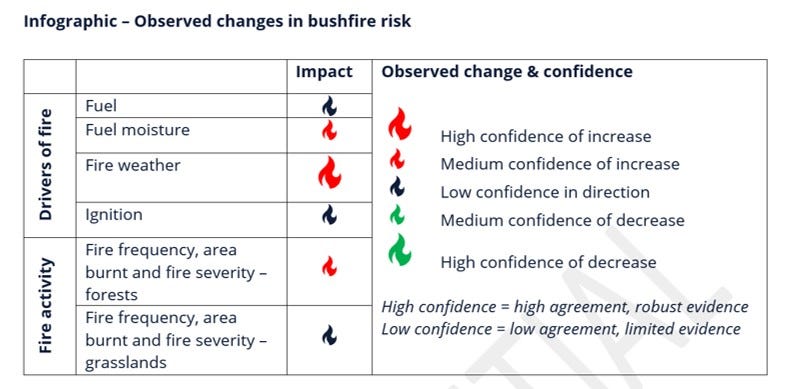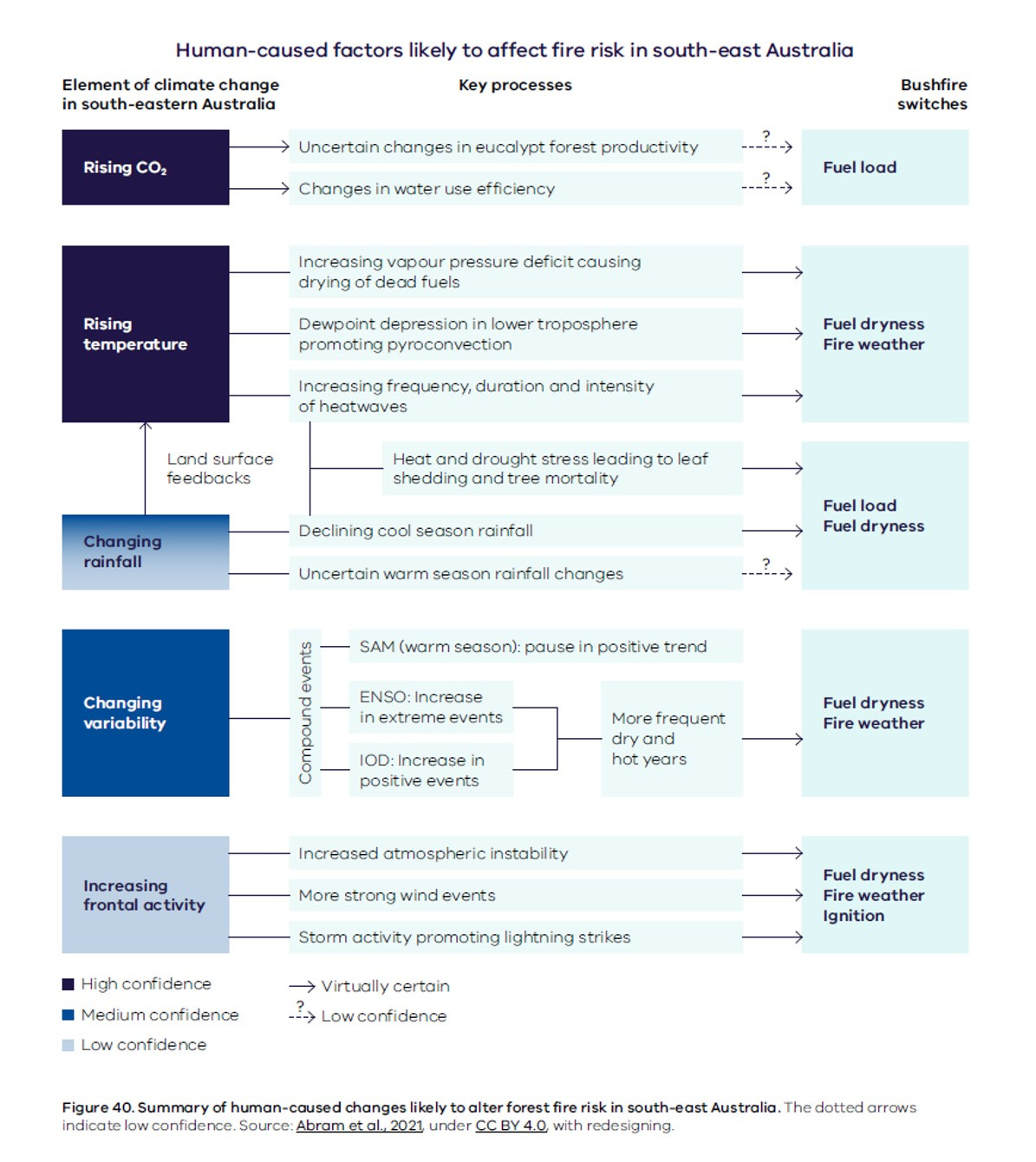Anything To Report?
On Victoria's Climate Science Report 2024
On the 26th of November 2024, under Section 51 of the Climate Change Act 2017, an unnamed Clerk* tabled Victoria’s Climate Science Report 2024 (VCSR24, there’s always an acronym).
At 112 pages it is quite small for a five year summary of the science, observations, impacts and projections of climate change in Victoria**. At 112 pages it is quite big for a document the authors are presumably hoping many people will read. Luckily, the team behind it at the Department of Energy, Environment and Climate Action have taken care to produce a range of headline statements, fact sheets, regional summaries and infographics. Here are their take home messages:
Victoria’s climate has continued to warm since the 19th century, becoming drier in recent decades and experiencing more frequent and intense climate hazards.
Victoria will experience a warmer future climate with further increases to average temperatures and more frequent and intense hot days.
Victoria is likely to continue to become drier, especially in winter and throughout the cool season (April – October), while the intensity of short duration extreme rainfall events is projected to increase.
High-impact climate hazards that affect Victoria, including floods, heatwaves, drought, bushfires and sea-level rise, are also changing and are projected to exacerbate under a warming climate.
VCSR24 highlights that we can minimise the impacts of climate change if global emissions achieve a low emissions scenario. This shows that it is not too late to act, and that further action to reduce greenhouse gas emissions is crucial to reducing the impacts of climate change.
The report is an accompanied by a tool - a word to strike fear into the hearts of researchers and consultants alike - that allows you to fiddle around with the data behind the report. A huge amount of work has clearly gone into the creation of this tool (Victoria’s Future Climate Tool). There’s maps, layers, copious explanatory text, you can zoom and you can download in multiple formats (TIFF, JSON, Shapefile, ASCII), heck you can even upload your own polygons to cookie cut the results.
Why am I writing about this report? The answer is threefold.
This is the go to document if you want to know anything about what is happening with Victoria’s climate, and associated climate hazards. It is hot off the presses and will stay relevant for many years. Even if you’re not from these parts, you might be interested in the kinds of stuff that make it into the report, and the kinds of ways that stuff is presented.
Me and my colleagues Tori Reynolds and Tom Fairman wrote one of the chapters (well - a technical report that underpinned the fire chapter). We tried to give some high level context for fire (it’s ancient, it’s global, it’s local, it’s cultural, it’s got drivers etc). We talked about some observed trends in fire and its drivers (weather, fuel, dryness, ignition) in Victoria, and we talked about some studies projecting future changes in fire and its drivers.
We had a crack at making an infographic but they made a few revisions to it for the final cut. I’ll let you be the judge as to whether either of these are any good. Here’s the final report version:

And here’s our earlier draft version, split into observed and projected changes:

We make a few points that I may have made on this blog before: the future is hard to predict and fire is complicated. There’s even a neat figure that gives us a glimpse of this complexity, pinched from a paper that Nerilie Abram led, which I contributed to.
Now where was I? Oh, that’s right, the threefold answer.
The report serves as a high quality reminder of our tendency as a culture to invest thousands of person hours in the creation of highly information-dense documents which I fear are destined to sink without a trace into our ever expanding memory hole***. Allow me to quote at length an obscure 21st century blogger on this topic:
At a meeting with some colleagues and industry partners today, we discussed a research report done by some other academics a few years ago. It was generally agreed that the report was good, but that we weren’t across all the details and we weren’t sure how relevant or applicable they were to the task we were discussing in the meeting. Our partners wanted us to take a closer look at this report and if necessary build on it. The song Another One Bites The Dust started playing in my mind. [Ed. I can’t remember the meeting either!]
I was reminded of an idea I’ve had for some time, for some kind of platform, service, tool or mechanism for unearthing, extracting and sharing goodness from the absolute Mariana Trench-deep ocean of reports that currently lie dormant on digital shelves, gathering digital dust (often within days or weeks of their ballyhooed release). I am not just talking wildfire or climate change, or even science. Governments of all sizes and stripes are constantly putting together hefty tomes on all manner of topics. Some of these reports are really, really good. And what happens to many of them? They sink, with nary a trace. What a waste.
How do we keep these riches alive?
On Mastodon I follow a Bird Bot and an IronChef Bot, that regularly send out automated pictures of birds and screenshots from Kitchen Stadium. Should we make a Report Bot, that toots about and links to random old and new government reports? While we’re at it, we could make a NiceFigure Bot (no, not that kind, I’m talking about plots) and a JournalArticle Bot. Couldn’t a clever student pull that off in a few days? Could this be a contender for this year’s version of the scheme I spammed back in ‘23? Is it time to dust off the Grant Application Apparatus?
Could the answer, or at least part of it, be evidence briefs that can deftly handle different disciplines and knowledge types, confidently communicating the boundaries of certainty and uncertainty, while transparently declaring their authorship and methods? I’d like to think so but they are after all just another bunch of documents [red face emoji].
Could we just get a rando to start poring over random old reports, one at a time?
Then again, maybe the problem is the perpetual creation of all these reports in the first place. Far be it from me to poo poo shrines to knowledge… but could we maybe think of some better ways to collect, share and preserve knowledge than the current Report-O-Rama, right?
One thing that leaves me with a little bit of hope is that right at the top of the report is a page about First Peoples and climate change****. Sure, these are words not actions (a different kind of challenge for the boatload of hitherto mentioned reports), but I prefer them to be in there rather than not.
The Victorian Government acknowledges the nuance and sophistication of traditional knowledge systems developed and maintained by Aboriginal communities to sustainably manage the long-term and multilayered relationships with their land, waters and air. The concept of holding both Aboriginal and western world views can enable a dialogue between Traditional Owners and government that does not exclude one or the other world view.
The Victorian Government acknowledges that the impact and structures of colonisation still exist today. Colonisation has created disparities in health and wellbeing through the dispossession of traditional land and waters, suppression of traditional knowledge and structural racism. Given this colonial legacy, Aboriginal people are subject to higher rates of socio-economic disadvantage, which in turn exacerbates the impact of climate change on the health of these populations.
The Victorian Government recognises that only Traditional Owners can speak for Country and the knowledge, know-how, skills and practices of traditional knowledge systems….We acknowledge our obligation to ensure that intellectual property rights and data sovereignty are maintained and protected and that supporting self-determination involves transferring decision making control and resources to Aboriginal communities on matters affecting their lives.
The other day I was watching The Knowledge Keepers, a great documentary on SBS about Indigenous knowledge and climate change, and during it someone spoke about the importance of being patient. I immediately resonated to this word, probably because I have felt myself racing stupidly towards something for quite some time. Patience feels like a hard value to maintain in our frenetic, troubling times. I am moving, painfully slowly and in my own way, towards meaning collaboration with Indigenous researchers, knowledge holders and communities. In fact, I have just struck up a little project (in a delightfully loose sense of the word) with a few colleagues that I am rather excited about. But I’d better pace myself. From little things, big things grow.
~~~
* Not to be confused with an unnamed Clarke. The Climate Science Report was one of a handful of reports, notices, documents and proclamations tabled that day. If I have trouble keeping up with the deluge of scientific literature (and regular readers will know I do), then spare a thought for those trying to keep up with what I can only assume is a similar-sized deluge of legislation and legal documents.
** The report is a sequel, to a similarly mandated report back in 2019.
*** I never found the term ‘memory hole’ compelling. I get it, the memories go in the hole and then they’re gone. But it’s way too vague and clunky a metaphor for something so important as our inability (via suppression or other means) to remember important things. Please give me some alternatives, and don’t use GPT.
**** This page was immediately below below the Minister’s Foreword, a strange ritual adhered to in many government reports whereby the Minister’s speech writer leaves a few dry and entirely unnecessary words along with a shot of the Minister after the title page. MinistersForeword Bot, anyone?




RE tools for sifting through reports - an appropriate place to plug Tasmania's own Cameron Atkinson and his PhD work (I'll introduce you at NHRA if you haven't met yet?). Might feed nicely into your evidence briefs!
Cam is guaranteed for a fun conversation!